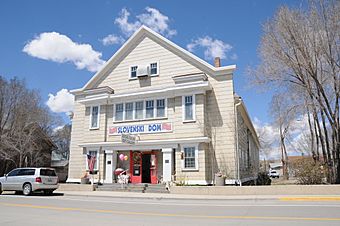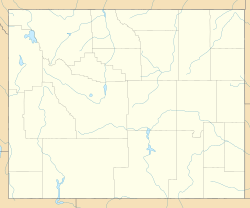Slovenski Dom facts for kids
Quick facts for kids |
|
|
Slovenski Dom
|
|
 |
|
| Location | 513 Bridger Ave., Rock Springs, Wyoming |
|---|---|
| Area | less than one acre |
| Architect | James, Thomas Alma |
| Architectural style | frame meeting hall |
| NRHP reference No. | 97001601 |
| Added to NRHP | December 30, 1997 |
The Slovenski Dom (pronounced SLO-ven-skee Dom) is a historic building in Rock Springs, Wyoming. It was built in 1913 as a special meeting place for Slovenian-American groups. These groups were like clubs that helped people from Slovenia who had moved to America. The name "Slovenski Dom" means "Slovenian National Home" in the Slovenian language. This building is the only one of its kind in Wyoming. It was added to the National Register of Historic Places in 1997, which means it's an important historical site.
Contents
Building the Slovenski Dom
Several Slovenian clubs, called Lodges, decided to build a community hall. These clubs originally helped miners and their families. They offered things like hospital and death benefits. They also provided fun social events for everyone.
The clubs worked with the Superior Lumber Company to build the hall. The building cost $9,440. Most of the money came from selling special building bonds to people in the community. The hall was finished just in time for a big New Year's Eve dance on December 31, 1913. The original clubs still own the building today.
What the Hall Looks Like
The outside of the building was first made of wooden shiplap. This was a type of wooden siding. In the 1980s, it was covered with asbestos siding. The original roof was made of wooden shingles.
Inside, the building still looks a lot like it did in 1913. Not many of the original furniture pieces are left. Each club used to have its own desk, but only two are still there. You can still see many of the green wooden benches that were used for seating in the main hall. Above the stage, there is a large screen. It shows a picture of a Slovenian castle on an island. This screen was painted in the 1950s.
A Busy Community Hub
The Slovenski Dom quickly became a very important place for the community. It helped Slovenian-Americans keep their traditions alive. People used the hall to practice their religion, play music, speak their language, and share other customs.
Many different groups held meetings there. These included Slovenian, Croatian, and Italian clubs. The local chapters of the United Mine Workers also met at the Dom. The hall was also used for fun events like:
- Dances
- Funny plays performed in Slovenian
- Raffles
Other events included fundraisers to help different causes. The Dom was also the first place where the Grape Festival was held. This festival was a celebration of the harvest. The hall would be decorated with fruit and leaves. People would enjoy ethnic dancing and short plays. The first Grape Festival was in 1922, and the last one was in 1988.
Music at the Dom
The Slovenski Dom played a big role in keeping Slovenian music traditions alive. Local bands provided music for the dances. Some famous bands included the Willie Yugovich Orchestra in the 1930s and 1940s. Elsie Frolic's band played there in the 1950s and 1960s.
These bands often used instruments like:
- Button accordions
- Tubas
- Clarinets
- Pianos
- Drums
These groups were like the early versions of the bands that play at today's yearly polka festival.
The Dom Today
Today, the Slovenski Dom is not used for its original purpose. Instead, it is rented out to a company. This company sells products made by local artists.
- Inside panorama of the Slovenski Dom today.



